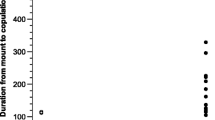Abstract
Male mate choice in Brachionus plicatilis is based on information from coronal receptors and contact chemoreception of a glycoprotein signal on the body surface of females. Male mating behavior is modulated by mating signal quality and strength, which determines male mating persistence and circling intensity. We probe the sensory abilities of males by better resolving their discrimination of female age. Males preferentially initiate mating with young females, but not too young. Males circle 0.2 h old females just hatched from resting eggs only about 1/2 as frequently as 12 h old females. Males are even more discriminating of females with whom they copulate, preferring 3 h old females significantly more than 0.2 h or 6 h old females. In contrast, males cannot distinguish between virgin females and those who have already copulated. Similarly, males circled and copulated with females hatching from resting eggs with equal frequency as those hatching from amictic eggs. The counterpoint to male mate choice is female resistance to mating. When males contact females, the females respond with one of four behaviors: no response, acceleration, foot flipping, or coronal retraction. In 65% of male–female encounters, there was no initial response by females. However, when males began circling females, females accelerated 11.1 times more often than when males were absent. The second type of evasive female behavior was foot-flipping, which tends to knock off males attempting to circle the female. In the presence of circling males, females performed foot-flipping behavior three times more often than in the absence of males. Coronal retraction, where they stop swimming and withdraw their corona, was observed less frequently than acceleration or foot-flipping, and there was no difference in the presence or absence of males. These data are interpreted in the context of sexual conflict, where the behaviors that optimize male and female fitness differ.


Similar content being viewed by others
References
Aloia, R. C. & R. L. Moretti, 1973. Mating behavior and ultrastructtural aspects of copulation in the rotifer Asplanchna brightwelli. Transactions of the American Microscopical Society 92: 371–380.
Arnqvist, G. & L. Rowe, 2005. Sexual Conflict. Princeton University Press, Princeton, New Jersey.
Chapman, T., G. Arnqvist, J. Bangham & L. Rowe, 2003. Sexual conflict. Trends in Ecology and Evolution 18: 41–47.
Eberhard, W. G., 2002. The function of female resistance behavior: intromission by male coercion vs female cooperation in sepsid flies (Diptera: Sepsidae). Revista de Biologia Tropical 50: 485–505.
Eberhard, W. G. & C. Codero, 2003. Sexual conflict and female choice. Trends in Ecology and Evolution 18: 438–439.
Gilbert, J. J., 1963. Contact chemoreception, mating behaviour, and sexual isolation in the rotifer genus Brachionus. Journal of Experimental Biology 40: 625–641.
Gilbert, J. J., 1988. Rotifera. In Adiyodi, K. G. & R. G. Adiyodi (eds), Reproductive Biology of Invertebrates. Fertilization, Development and Parental Care, Vol. IV. Oxford and IBH Publishing Company, New Delphi, 179–199.
Gilbert, J. J. & E. J. Walsh, 2005. Brachionus calyciflorus is a species complex: mating behavior and genetic differentiation among four geographically isolated strains. Hydrobiologia 546: 257–265.
Gómez, A. & M. Serra, 1995. Behavioral reproductive isolation among sympatric strains of Brachionus plicatilis Muller 1786: insights into the status of this taxonomic species. Hydrobiologia 313/314: 111–119.
Gómez, A. & M. Serra, 1996. Mate choice in male Brachionus plicatilis rotifers. Functional Ecology 10: 681–687.
Gómez, A, M. Serra, G. R. Carvalho & D. H. Lunt, 2002. Speciation in ancient cryptic species complexes: evidence from the molecular phylogeny of Brachionus plicatilis (Rotifera). Evolution 56: 1431–1444.
Guillard, R. R. L., 1983. Culture of phytoplankton for feeding marine invertebrates. In Berg, C. J. Jr. (ed.), Culture of Marine Invertebrates. Hutchinson Ross, Stroudsburg, PA.
Ortells, R., T. W. Snell, A. Gómez & M. Serra, 2000. Patterns of genetic differentiation in resting egg banks of a rotifer species complex in Spain. Archives fur Hydrobiologia 149: 529–551.
Rico-Martinez, R. & T. W. Snell, 1995. Male discrimination of female Brachionus plicatilis Muller and B. rotundiformis Tschugunoff (Rotifera). Journal of Experimental Marine Biology & Ecology 190: 39–49.
Schröder, T., 2003. Precopulatory mate guarding and mating behaviour in the rotifer Epiphanes senta (Monogononta, Rotifera). Proceedings of the Royal Society of London, Series B. 270: 1965–1970.
Snell, T. W., 1989. Systematics, reproductive isolation and species boundaries in monogonont rotifers. Hydrobiologia 186/187: 299–310.
Snell, T. W. & C. A. Hawkinson, 1983. Behavioral reproductive isolation among populations of the rotifer Brachionus plicatilis. Evolution 37: 1294–1305.
Snell, T. W. & M. Childress, 1987. The effect of age on male and female fertility in the rotifer Brachionus plicatilis. Journal of Invertebrate Reproduction & Development 12: 103–110.
Snell, T. W. & F. H. Hoff, 1987. Fertilization and male fertility in the rotifer Brachionus plicatilis. Hydrobiologia 147: 329–334.
Snell, T. W., R. Rico-Martinez, L. N. Kelly & T. E. Battle, 1995. Identification of a sex pheromone from a rotifer. Marine Biology 123: 347–353.
Snell, T. W., J. M. Kubanek, W. E. Carter, A. B. Payne, J. Kim, M. Hicks & C. P. Stelzer, 2006. A protein signal triggers sexual reproduction in Brachionus plicatilis (Rotifera). Marine Biology 149: 763–773.
Acknowledgment
This work was supported by the National Science Foundation grants BE/GenEn MCB-0412674 to TWS.
Author information
Authors and Affiliations
Corresponding author
Additional information
Guest editors: S. S. S. Sarma, R. D. Gulati, R. L. Wallace, S. Nandini, H. J. Dumont & R. Rico-Martínez
Advances in Rotifer Research
Rights and permissions
About this article
Cite this article
Snell, T.W., Kim, J., Zelaya, E. et al. Mate choice and sexual conflict in Brachionus plicatilis (Rotifera). Hydrobiologia 593, 151–157 (2007). https://doi.org/10.1007/s10750-007-9065-6
Published:
Issue Date:
DOI: https://doi.org/10.1007/s10750-007-9065-6




